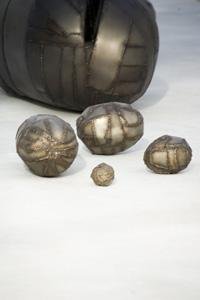Magdalena Abakanowicz
dal 12/3/2008 al 15/6/2008
Segnalato da
Museo Nacional Centro de Arte Reina Sofia
12/3/2008
Magdalena Abakanowicz
Museo Nacional Centro de Arte Reina Sofia, Madrid
King Arthur's Court

Magdalena Abakanowicz (Falenty, Poland, 1930) has constructed a unique universe populated by groups or crowds of human figures, body fragments, trees and seeds, which occupy a geography somewhere between reality and dreams. In this imagined space, mythical references, literary figures, evocations from her childhood, the experience of a war-torn country and her life in a totalitarian regime in the Soviet orbit all come together. A compendium of images that unfolds in her mystery-filled, dynamic work.
Abakanowicz’s artistic language is characterised by monumentalism, a fascination with nature and a spatial conception of her sculptures, which when grouped into a single, site-specific creation produce a powerful, theatrical effect. In the mid-1960s, she achieved great acclaim at the 7th Sao Paulo Biennial with her Abakans, a name derived from her own surname and used to identify the enormous three-dimensional “tapestries”, simultaneously biomorphic and abstract, which she presented in a group, like an enigmatic forest of totems. These creations enabled her to transform the idea of a flat tapestry into a form capable of organising space from an entirely sculptural concept. In Ropes (1970) she takes this proposal even further by deconstructing and expanding the textile materials in space, which are intertwined like muscles striving to release their energy, transcending formal boundaries. This interest in the organic and the biological is manifested with greater force in Alterations, her next work, displayed as series - Heads, Seated Figures, Backs, Embryology - in which a distinct formal asceticism removes everything that is superfluous and concentrates on the exterior surface that forms a body, a meaningful, differentiated epidermis with visible traces of the human condition.
From textile materials Abakanowicz went on to explore the possibilities of harder, more durable materials such as bronze, wood and stainless steel. In the mid-1980s she presented Katarsis, a composition of 33 monumental figures in the open air, which marked the beginning of a series of monumental projects in outdoor spaces, because in addition to its distinctly organic nature, Abakanowicz’s work also attempts to transcend formal aspects and occupy "a space to experience”. Her installations are populated by crowds of bodies, bronze or wooden figures, heads of men, animals and dragons, trees that blend with human hands and torsos. The variety of multiplied yet different figures that compose her crowds reveals the tension between the individual and the social, identity and anonymity, desire and reality.
In this exhibition entitled King Arthur’s Court, mounted beneath a protective marquee, Abakanowicz presents a selection of representative works from her long career, such as Embryology and Bambini, and new pieces on display here for the first time. Everything coexists in a single space, protected and isolated from the outside world by the marquee that the artist has designed for the interior of the Palacio de Cristal.
Embriology belongs to the Alterations series that she first began to work on in the 1970s. The simple forms of the numerous seeds, made in stainless steel, seem to evolve into abstraction, a phenomenon that is repeated in Bambini, with its disfigured bodies – part human torso, part tree – which are hollowed out and apparently lacking in individuality. There is a connection between these works and the figures of the Knights of the Round Table: schematic stainless steel constructions whose vitality seeps through to the surface, in those welded-on scars that seem to trace a story on the body. In the Palacio de Cristal in the Retiro Park, these figures become a fantastical narrative of metal artefacts and nature.
Myth and the fantastic are recurrent themes in Abakanowicz’s work. The legend of King Arthur also provides her with a pretext for discussing lost values in a world in which military force is used immorally to defend strategic positions. In the legend, the knights were guided by principles, ethics and dignity. Here, they coexist with the Bambini and the embryonic forms of the Embriology series, like a metaphorical image of the visions that emerge between objective reality and ineffable dreams.
Museo Nacional Centro de Arte Reina Sofia
Santa Isabel, 52 - Madrid
Hours: Monday to Saturday from 10:00 to 18:00 h; Sunday and Holidays from 10:00 to 16:00 h; Closed on Tuesday



